Improving Organizational Performance: BUNI Travel Report
VerifiedAdded on 2023/03/17
|15
|3380
|74
Report
AI Summary
This report examines people and performance management strategies for BUNI Travel, a local travel agency aiming to improve its organizational performance. As the new Human Resource Manager, the report addresses several key areas, including tools and techniques for enhancing performance, such as key performance indicators (KPIs), performance appraisals, reward and recognition programs, performance management frameworks (like balanced scorecards), and personal development plans. It also explores the crucial role of employee wellbeing in boosting motivation and performance, considering psychological, physical, and social aspects. Furthermore, the report emphasizes the impact of external factors on managing people, such as government regulations and economic conditions. The PESTLE analysis of BUNI Travel is also included. The report provides a comprehensive overview of people management practices and their impact on organizational success, offering recommendations for BUNI Travel to enhance its human resource function and achieve its business objectives.
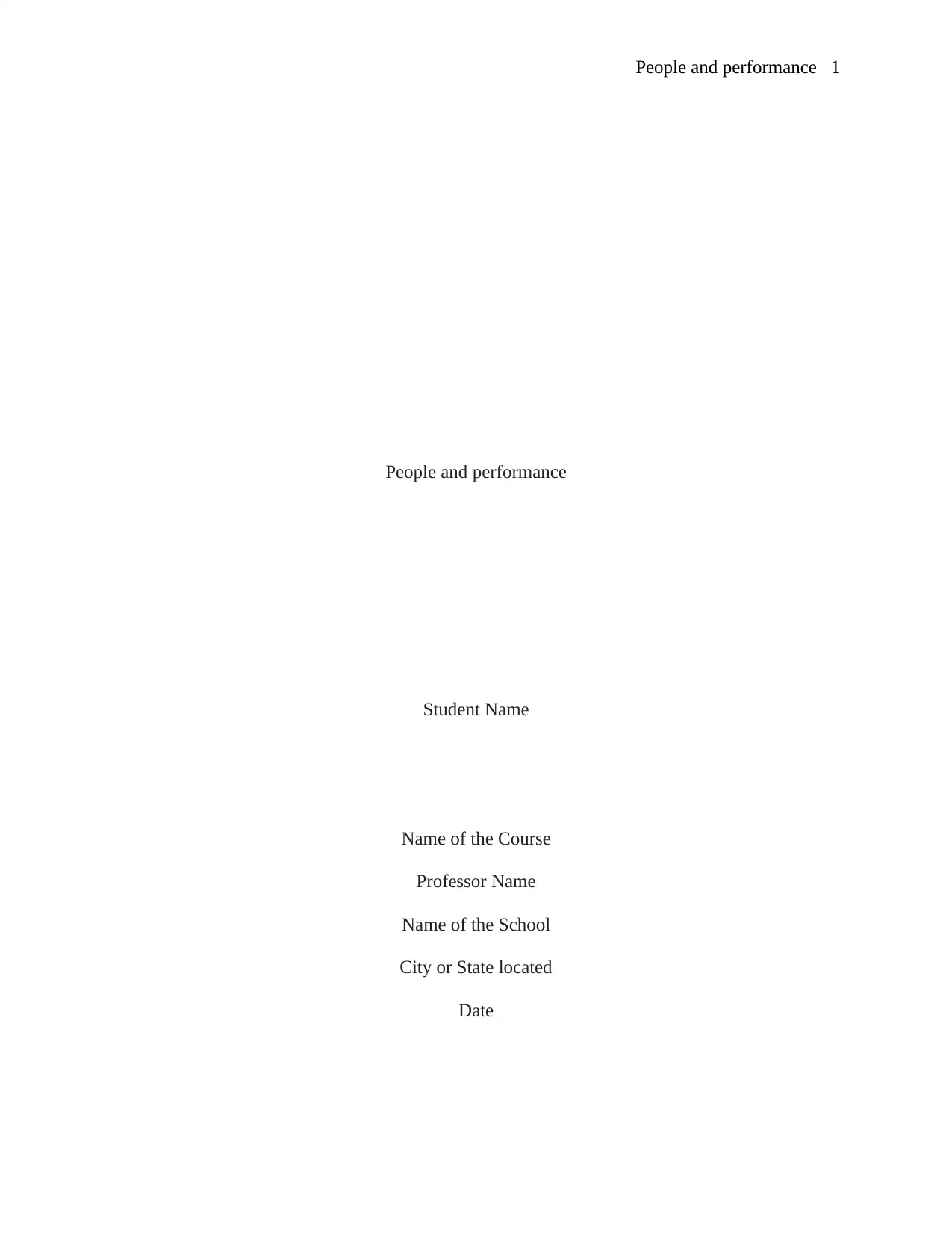
People and performance 1
People and performance
Student Name
Name of the Course
Professor Name
Name of the School
City or State located
Date
People and performance
Student Name
Name of the Course
Professor Name
Name of the School
City or State located
Date
Paraphrase This Document
Need a fresh take? Get an instant paraphrase of this document with our AI Paraphraser
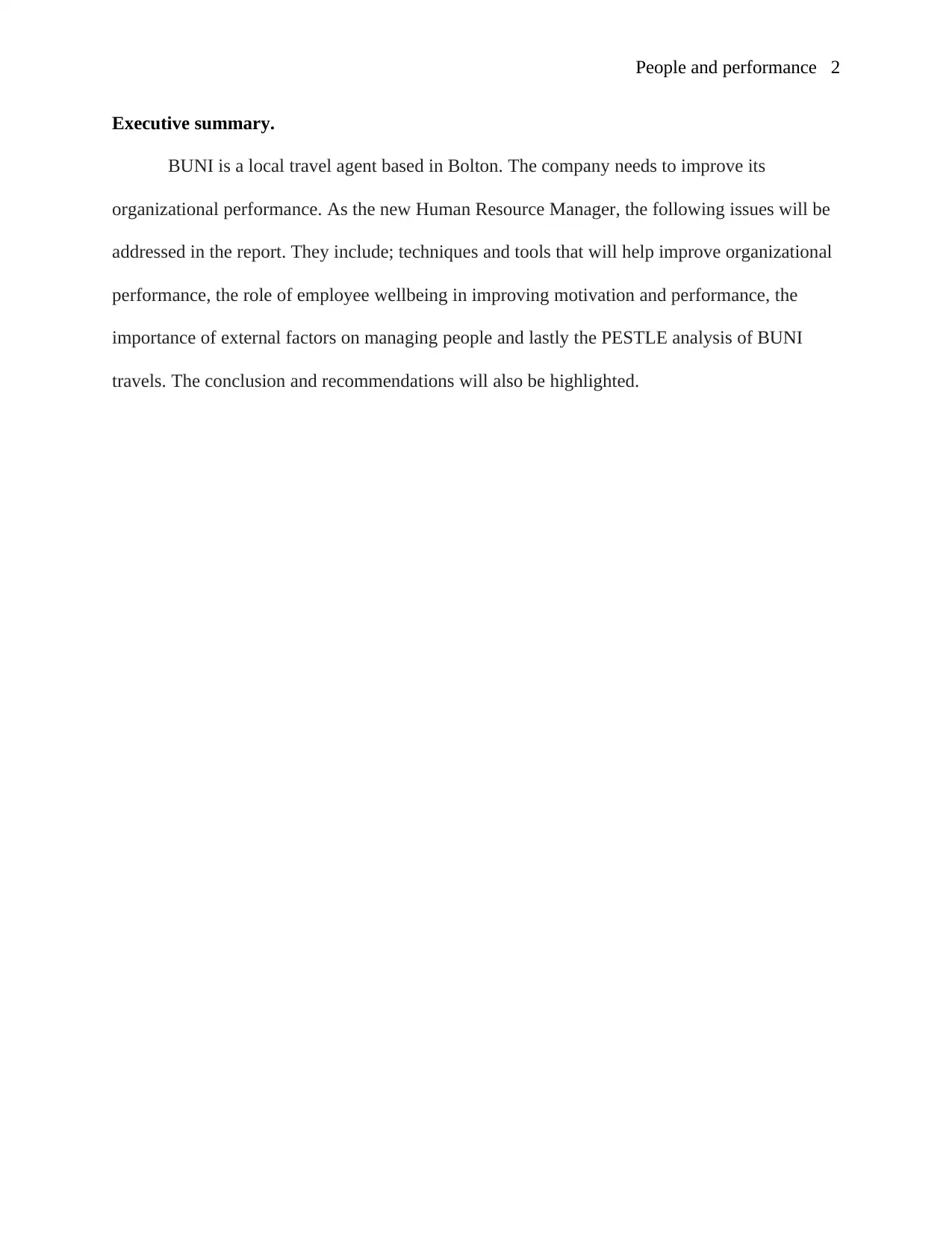
People and performance 2
Executive summary.
BUNI is a local travel agent based in Bolton. The company needs to improve its
organizational performance. As the new Human Resource Manager, the following issues will be
addressed in the report. They include; techniques and tools that will help improve organizational
performance, the role of employee wellbeing in improving motivation and performance, the
importance of external factors on managing people and lastly the PESTLE analysis of BUNI
travels. The conclusion and recommendations will also be highlighted.
Executive summary.
BUNI is a local travel agent based in Bolton. The company needs to improve its
organizational performance. As the new Human Resource Manager, the following issues will be
addressed in the report. They include; techniques and tools that will help improve organizational
performance, the role of employee wellbeing in improving motivation and performance, the
importance of external factors on managing people and lastly the PESTLE analysis of BUNI
travels. The conclusion and recommendations will also be highlighted.
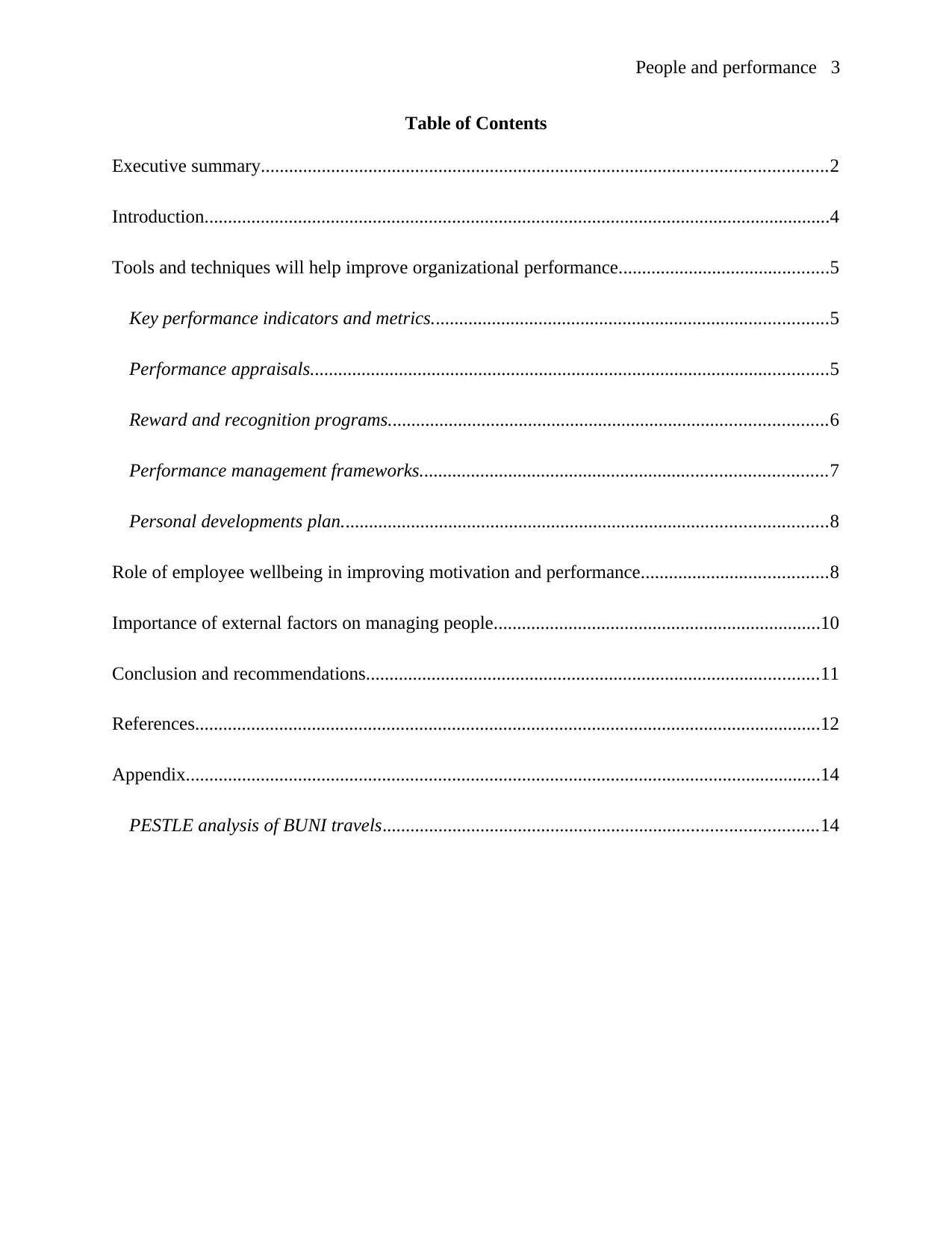
People and performance 3
Table of Contents
Executive summary.........................................................................................................................2
Introduction......................................................................................................................................4
Tools and techniques will help improve organizational performance.............................................5
Key performance indicators and metrics.....................................................................................5
Performance appraisals...............................................................................................................5
Reward and recognition programs..............................................................................................6
Performance management frameworks.......................................................................................7
Personal developments plan........................................................................................................8
Role of employee wellbeing in improving motivation and performance........................................8
Importance of external factors on managing people......................................................................10
Conclusion and recommendations.................................................................................................11
References......................................................................................................................................12
Appendix........................................................................................................................................14
PESTLE analysis of BUNI travels.............................................................................................14
Table of Contents
Executive summary.........................................................................................................................2
Introduction......................................................................................................................................4
Tools and techniques will help improve organizational performance.............................................5
Key performance indicators and metrics.....................................................................................5
Performance appraisals...............................................................................................................5
Reward and recognition programs..............................................................................................6
Performance management frameworks.......................................................................................7
Personal developments plan........................................................................................................8
Role of employee wellbeing in improving motivation and performance........................................8
Importance of external factors on managing people......................................................................10
Conclusion and recommendations.................................................................................................11
References......................................................................................................................................12
Appendix........................................................................................................................................14
PESTLE analysis of BUNI travels.............................................................................................14
⊘ This is a preview!⊘
Do you want full access?
Subscribe today to unlock all pages.

Trusted by 1+ million students worldwide
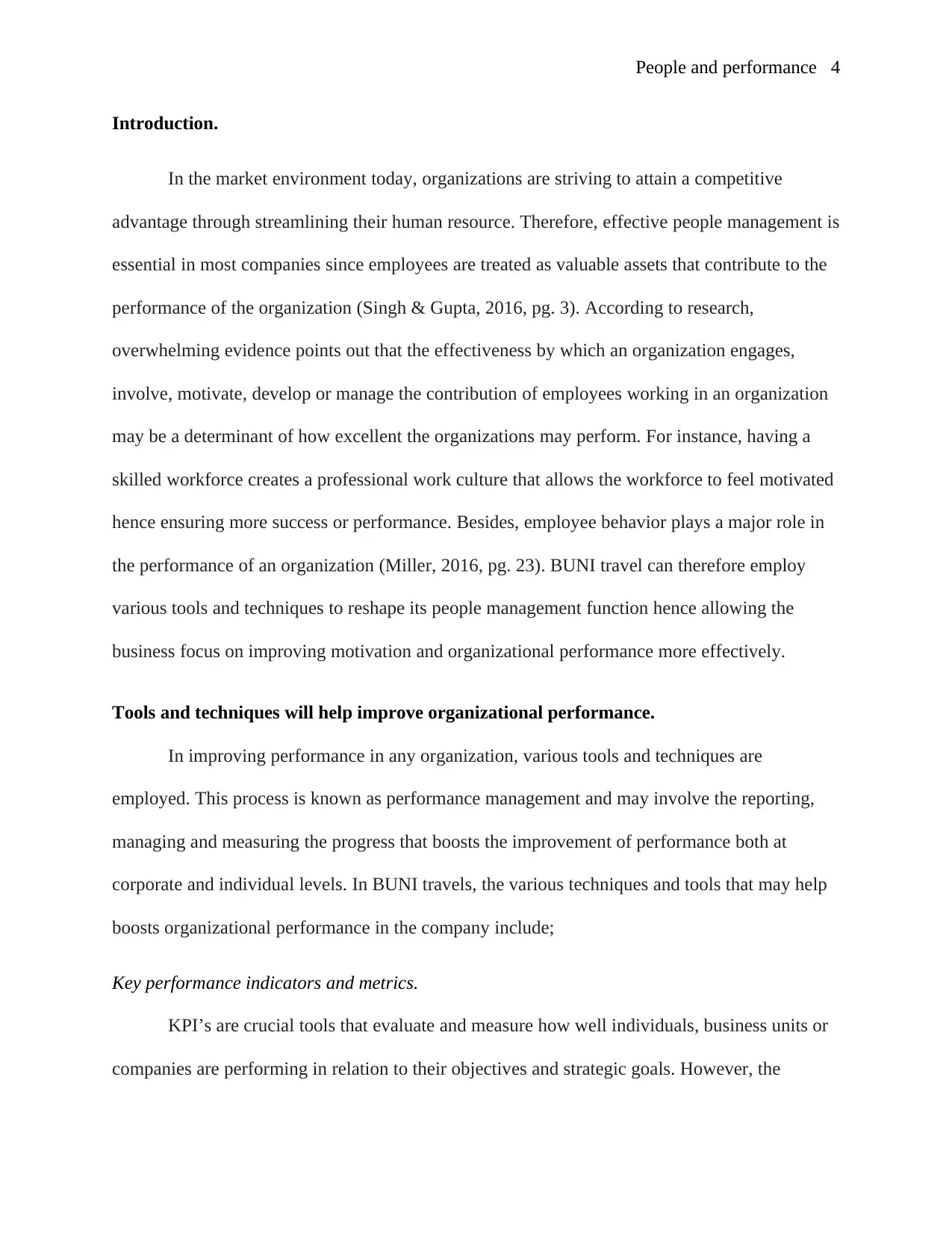
People and performance 4
Introduction.
In the market environment today, organizations are striving to attain a competitive
advantage through streamlining their human resource. Therefore, effective people management is
essential in most companies since employees are treated as valuable assets that contribute to the
performance of the organization (Singh & Gupta, 2016, pg. 3). According to research,
overwhelming evidence points out that the effectiveness by which an organization engages,
involve, motivate, develop or manage the contribution of employees working in an organization
may be a determinant of how excellent the organizations may perform. For instance, having a
skilled workforce creates a professional work culture that allows the workforce to feel motivated
hence ensuring more success or performance. Besides, employee behavior plays a major role in
the performance of an organization (Miller, 2016, pg. 23). BUNI travel can therefore employ
various tools and techniques to reshape its people management function hence allowing the
business focus on improving motivation and organizational performance more effectively.
Tools and techniques will help improve organizational performance.
In improving performance in any organization, various tools and techniques are
employed. This process is known as performance management and may involve the reporting,
managing and measuring the progress that boosts the improvement of performance both at
corporate and individual levels. In BUNI travels, the various techniques and tools that may help
boosts organizational performance in the company include;
Key performance indicators and metrics.
KPI’s are crucial tools that evaluate and measure how well individuals, business units or
companies are performing in relation to their objectives and strategic goals. However, the
Introduction.
In the market environment today, organizations are striving to attain a competitive
advantage through streamlining their human resource. Therefore, effective people management is
essential in most companies since employees are treated as valuable assets that contribute to the
performance of the organization (Singh & Gupta, 2016, pg. 3). According to research,
overwhelming evidence points out that the effectiveness by which an organization engages,
involve, motivate, develop or manage the contribution of employees working in an organization
may be a determinant of how excellent the organizations may perform. For instance, having a
skilled workforce creates a professional work culture that allows the workforce to feel motivated
hence ensuring more success or performance. Besides, employee behavior plays a major role in
the performance of an organization (Miller, 2016, pg. 23). BUNI travel can therefore employ
various tools and techniques to reshape its people management function hence allowing the
business focus on improving motivation and organizational performance more effectively.
Tools and techniques will help improve organizational performance.
In improving performance in any organization, various tools and techniques are
employed. This process is known as performance management and may involve the reporting,
managing and measuring the progress that boosts the improvement of performance both at
corporate and individual levels. In BUNI travels, the various techniques and tools that may help
boosts organizational performance in the company include;
Key performance indicators and metrics.
KPI’s are crucial tools that evaluate and measure how well individuals, business units or
companies are performing in relation to their objectives and strategic goals. However, the
Paraphrase This Document
Need a fresh take? Get an instant paraphrase of this document with our AI Paraphraser
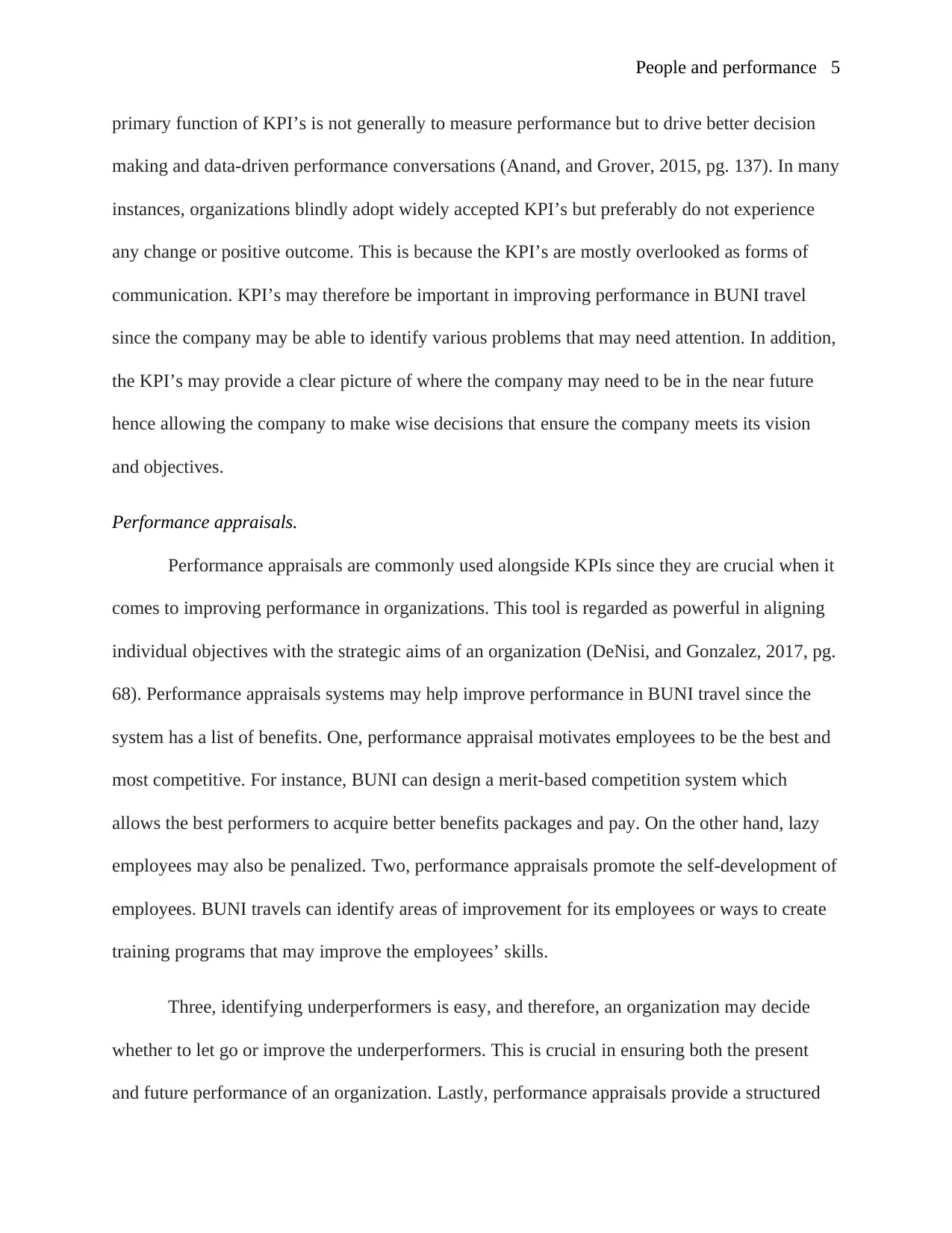
People and performance 5
primary function of KPI’s is not generally to measure performance but to drive better decision
making and data-driven performance conversations (Anand, and Grover, 2015, pg. 137). In many
instances, organizations blindly adopt widely accepted KPI’s but preferably do not experience
any change or positive outcome. This is because the KPI’s are mostly overlooked as forms of
communication. KPI’s may therefore be important in improving performance in BUNI travel
since the company may be able to identify various problems that may need attention. In addition,
the KPI’s may provide a clear picture of where the company may need to be in the near future
hence allowing the company to make wise decisions that ensure the company meets its vision
and objectives.
Performance appraisals.
Performance appraisals are commonly used alongside KPIs since they are crucial when it
comes to improving performance in organizations. This tool is regarded as powerful in aligning
individual objectives with the strategic aims of an organization (DeNisi, and Gonzalez, 2017, pg.
68). Performance appraisals systems may help improve performance in BUNI travel since the
system has a list of benefits. One, performance appraisal motivates employees to be the best and
most competitive. For instance, BUNI can design a merit-based competition system which
allows the best performers to acquire better benefits packages and pay. On the other hand, lazy
employees may also be penalized. Two, performance appraisals promote the self-development of
employees. BUNI travels can identify areas of improvement for its employees or ways to create
training programs that may improve the employees’ skills.
Three, identifying underperformers is easy, and therefore, an organization may decide
whether to let go or improve the underperformers. This is crucial in ensuring both the present
and future performance of an organization. Lastly, performance appraisals provide a structured
primary function of KPI’s is not generally to measure performance but to drive better decision
making and data-driven performance conversations (Anand, and Grover, 2015, pg. 137). In many
instances, organizations blindly adopt widely accepted KPI’s but preferably do not experience
any change or positive outcome. This is because the KPI’s are mostly overlooked as forms of
communication. KPI’s may therefore be important in improving performance in BUNI travel
since the company may be able to identify various problems that may need attention. In addition,
the KPI’s may provide a clear picture of where the company may need to be in the near future
hence allowing the company to make wise decisions that ensure the company meets its vision
and objectives.
Performance appraisals.
Performance appraisals are commonly used alongside KPIs since they are crucial when it
comes to improving performance in organizations. This tool is regarded as powerful in aligning
individual objectives with the strategic aims of an organization (DeNisi, and Gonzalez, 2017, pg.
68). Performance appraisals systems may help improve performance in BUNI travel since the
system has a list of benefits. One, performance appraisal motivates employees to be the best and
most competitive. For instance, BUNI can design a merit-based competition system which
allows the best performers to acquire better benefits packages and pay. On the other hand, lazy
employees may also be penalized. Two, performance appraisals promote the self-development of
employees. BUNI travels can identify areas of improvement for its employees or ways to create
training programs that may improve the employees’ skills.
Three, identifying underperformers is easy, and therefore, an organization may decide
whether to let go or improve the underperformers. This is crucial in ensuring both the present
and future performance of an organization. Lastly, performance appraisals provide a structured
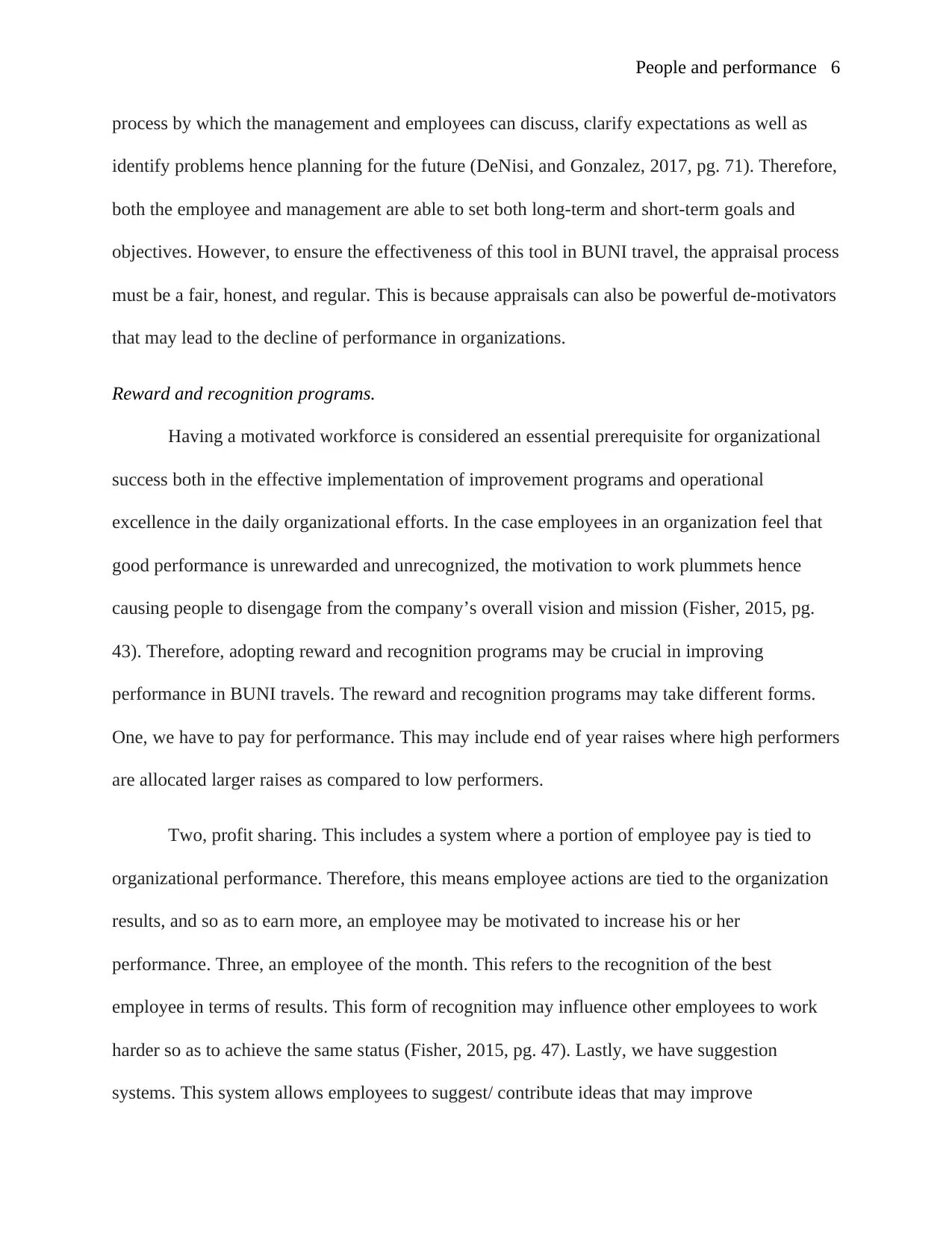
People and performance 6
process by which the management and employees can discuss, clarify expectations as well as
identify problems hence planning for the future (DeNisi, and Gonzalez, 2017, pg. 71). Therefore,
both the employee and management are able to set both long-term and short-term goals and
objectives. However, to ensure the effectiveness of this tool in BUNI travel, the appraisal process
must be a fair, honest, and regular. This is because appraisals can also be powerful de-motivators
that may lead to the decline of performance in organizations.
Reward and recognition programs.
Having a motivated workforce is considered an essential prerequisite for organizational
success both in the effective implementation of improvement programs and operational
excellence in the daily organizational efforts. In the case employees in an organization feel that
good performance is unrewarded and unrecognized, the motivation to work plummets hence
causing people to disengage from the company’s overall vision and mission (Fisher, 2015, pg.
43). Therefore, adopting reward and recognition programs may be crucial in improving
performance in BUNI travels. The reward and recognition programs may take different forms.
One, we have to pay for performance. This may include end of year raises where high performers
are allocated larger raises as compared to low performers.
Two, profit sharing. This includes a system where a portion of employee pay is tied to
organizational performance. Therefore, this means employee actions are tied to the organization
results, and so as to earn more, an employee may be motivated to increase his or her
performance. Three, an employee of the month. This refers to the recognition of the best
employee in terms of results. This form of recognition may influence other employees to work
harder so as to achieve the same status (Fisher, 2015, pg. 47). Lastly, we have suggestion
systems. This system allows employees to suggest/ contribute ideas that may improve
process by which the management and employees can discuss, clarify expectations as well as
identify problems hence planning for the future (DeNisi, and Gonzalez, 2017, pg. 71). Therefore,
both the employee and management are able to set both long-term and short-term goals and
objectives. However, to ensure the effectiveness of this tool in BUNI travel, the appraisal process
must be a fair, honest, and regular. This is because appraisals can also be powerful de-motivators
that may lead to the decline of performance in organizations.
Reward and recognition programs.
Having a motivated workforce is considered an essential prerequisite for organizational
success both in the effective implementation of improvement programs and operational
excellence in the daily organizational efforts. In the case employees in an organization feel that
good performance is unrewarded and unrecognized, the motivation to work plummets hence
causing people to disengage from the company’s overall vision and mission (Fisher, 2015, pg.
43). Therefore, adopting reward and recognition programs may be crucial in improving
performance in BUNI travels. The reward and recognition programs may take different forms.
One, we have to pay for performance. This may include end of year raises where high performers
are allocated larger raises as compared to low performers.
Two, profit sharing. This includes a system where a portion of employee pay is tied to
organizational performance. Therefore, this means employee actions are tied to the organization
results, and so as to earn more, an employee may be motivated to increase his or her
performance. Three, an employee of the month. This refers to the recognition of the best
employee in terms of results. This form of recognition may influence other employees to work
harder so as to achieve the same status (Fisher, 2015, pg. 47). Lastly, we have suggestion
systems. This system allows employees to suggest/ contribute ideas that may improve
⊘ This is a preview!⊘
Do you want full access?
Subscribe today to unlock all pages.

Trusted by 1+ million students worldwide
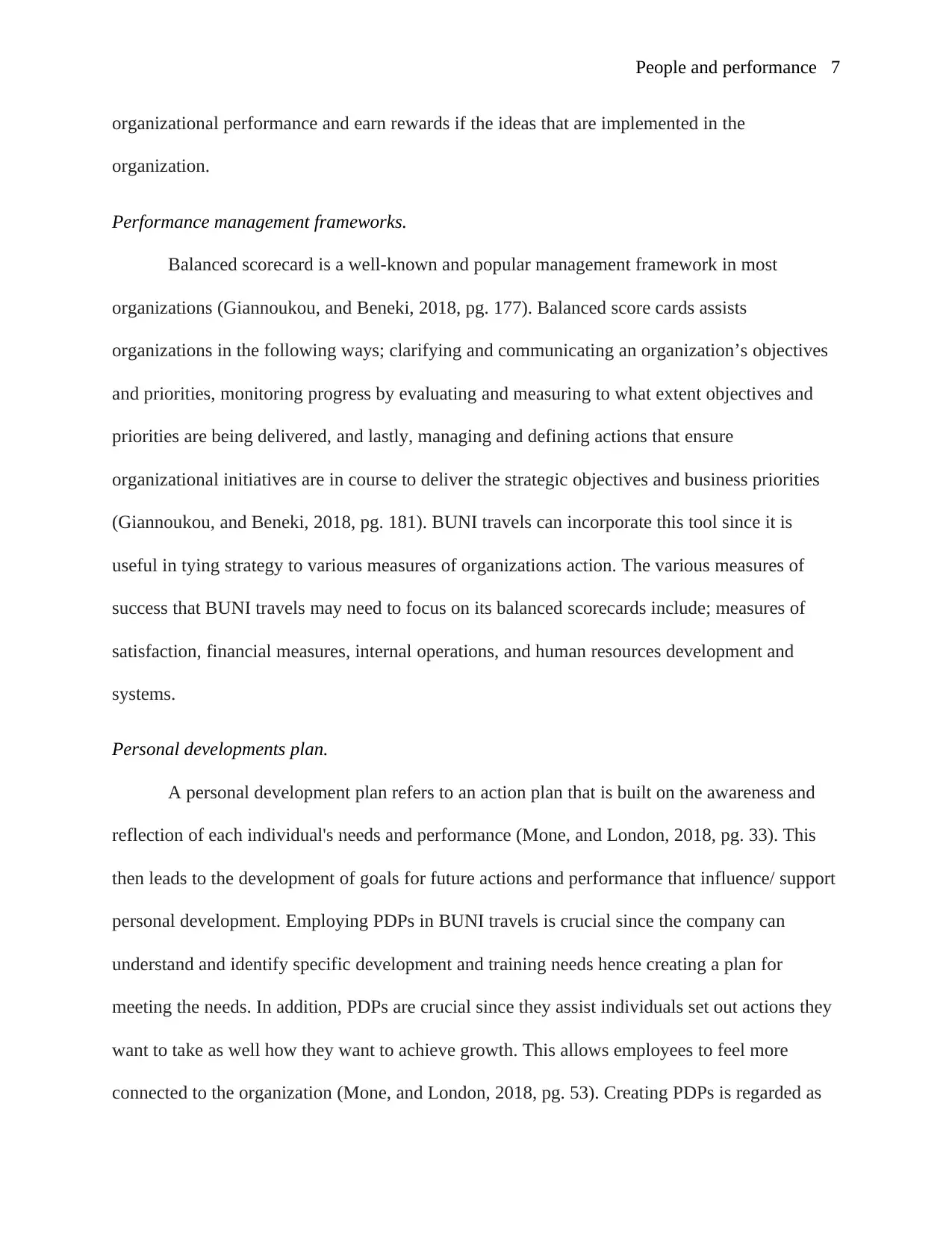
People and performance 7
organizational performance and earn rewards if the ideas that are implemented in the
organization.
Performance management frameworks.
Balanced scorecard is a well-known and popular management framework in most
organizations (Giannoukou, and Beneki, 2018, pg. 177). Balanced score cards assists
organizations in the following ways; clarifying and communicating an organization’s objectives
and priorities, monitoring progress by evaluating and measuring to what extent objectives and
priorities are being delivered, and lastly, managing and defining actions that ensure
organizational initiatives are in course to deliver the strategic objectives and business priorities
(Giannoukou, and Beneki, 2018, pg. 181). BUNI travels can incorporate this tool since it is
useful in tying strategy to various measures of organizations action. The various measures of
success that BUNI travels may need to focus on its balanced scorecards include; measures of
satisfaction, financial measures, internal operations, and human resources development and
systems.
Personal developments plan.
A personal development plan refers to an action plan that is built on the awareness and
reflection of each individual's needs and performance (Mone, and London, 2018, pg. 33). This
then leads to the development of goals for future actions and performance that influence/ support
personal development. Employing PDPs in BUNI travels is crucial since the company can
understand and identify specific development and training needs hence creating a plan for
meeting the needs. In addition, PDPs are crucial since they assist individuals set out actions they
want to take as well how they want to achieve growth. This allows employees to feel more
connected to the organization (Mone, and London, 2018, pg. 53). Creating PDPs is regarded as
organizational performance and earn rewards if the ideas that are implemented in the
organization.
Performance management frameworks.
Balanced scorecard is a well-known and popular management framework in most
organizations (Giannoukou, and Beneki, 2018, pg. 177). Balanced score cards assists
organizations in the following ways; clarifying and communicating an organization’s objectives
and priorities, monitoring progress by evaluating and measuring to what extent objectives and
priorities are being delivered, and lastly, managing and defining actions that ensure
organizational initiatives are in course to deliver the strategic objectives and business priorities
(Giannoukou, and Beneki, 2018, pg. 181). BUNI travels can incorporate this tool since it is
useful in tying strategy to various measures of organizations action. The various measures of
success that BUNI travels may need to focus on its balanced scorecards include; measures of
satisfaction, financial measures, internal operations, and human resources development and
systems.
Personal developments plan.
A personal development plan refers to an action plan that is built on the awareness and
reflection of each individual's needs and performance (Mone, and London, 2018, pg. 33). This
then leads to the development of goals for future actions and performance that influence/ support
personal development. Employing PDPs in BUNI travels is crucial since the company can
understand and identify specific development and training needs hence creating a plan for
meeting the needs. In addition, PDPs are crucial since they assist individuals set out actions they
want to take as well how they want to achieve growth. This allows employees to feel more
connected to the organization (Mone, and London, 2018, pg. 53). Creating PDPs is regarded as
Paraphrase This Document
Need a fresh take? Get an instant paraphrase of this document with our AI Paraphraser
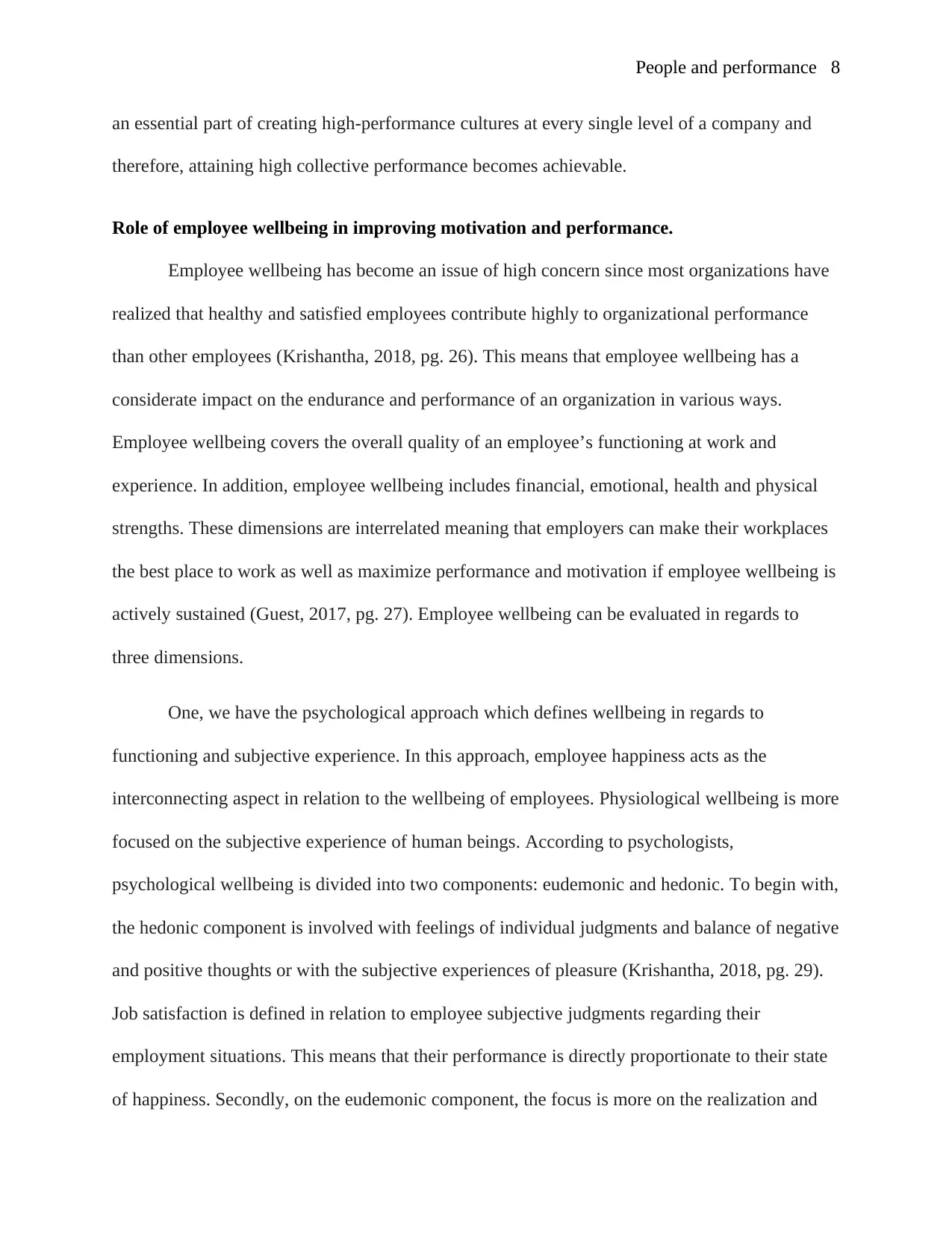
People and performance 8
an essential part of creating high-performance cultures at every single level of a company and
therefore, attaining high collective performance becomes achievable.
Role of employee wellbeing in improving motivation and performance.
Employee wellbeing has become an issue of high concern since most organizations have
realized that healthy and satisfied employees contribute highly to organizational performance
than other employees (Krishantha, 2018, pg. 26). This means that employee wellbeing has a
considerate impact on the endurance and performance of an organization in various ways.
Employee wellbeing covers the overall quality of an employee’s functioning at work and
experience. In addition, employee wellbeing includes financial, emotional, health and physical
strengths. These dimensions are interrelated meaning that employers can make their workplaces
the best place to work as well as maximize performance and motivation if employee wellbeing is
actively sustained (Guest, 2017, pg. 27). Employee wellbeing can be evaluated in regards to
three dimensions.
One, we have the psychological approach which defines wellbeing in regards to
functioning and subjective experience. In this approach, employee happiness acts as the
interconnecting aspect in relation to the wellbeing of employees. Physiological wellbeing is more
focused on the subjective experience of human beings. According to psychologists,
psychological wellbeing is divided into two components: eudemonic and hedonic. To begin with,
the hedonic component is involved with feelings of individual judgments and balance of negative
and positive thoughts or with the subjective experiences of pleasure (Krishantha, 2018, pg. 29).
Job satisfaction is defined in relation to employee subjective judgments regarding their
employment situations. This means that their performance is directly proportionate to their state
of happiness. Secondly, on the eudemonic component, the focus is more on the realization and
an essential part of creating high-performance cultures at every single level of a company and
therefore, attaining high collective performance becomes achievable.
Role of employee wellbeing in improving motivation and performance.
Employee wellbeing has become an issue of high concern since most organizations have
realized that healthy and satisfied employees contribute highly to organizational performance
than other employees (Krishantha, 2018, pg. 26). This means that employee wellbeing has a
considerate impact on the endurance and performance of an organization in various ways.
Employee wellbeing covers the overall quality of an employee’s functioning at work and
experience. In addition, employee wellbeing includes financial, emotional, health and physical
strengths. These dimensions are interrelated meaning that employers can make their workplaces
the best place to work as well as maximize performance and motivation if employee wellbeing is
actively sustained (Guest, 2017, pg. 27). Employee wellbeing can be evaluated in regards to
three dimensions.
One, we have the psychological approach which defines wellbeing in regards to
functioning and subjective experience. In this approach, employee happiness acts as the
interconnecting aspect in relation to the wellbeing of employees. Physiological wellbeing is more
focused on the subjective experience of human beings. According to psychologists,
psychological wellbeing is divided into two components: eudemonic and hedonic. To begin with,
the hedonic component is involved with feelings of individual judgments and balance of negative
and positive thoughts or with the subjective experiences of pleasure (Krishantha, 2018, pg. 29).
Job satisfaction is defined in relation to employee subjective judgments regarding their
employment situations. This means that their performance is directly proportionate to their state
of happiness. Secondly, on the eudemonic component, the focus is more on the realization and
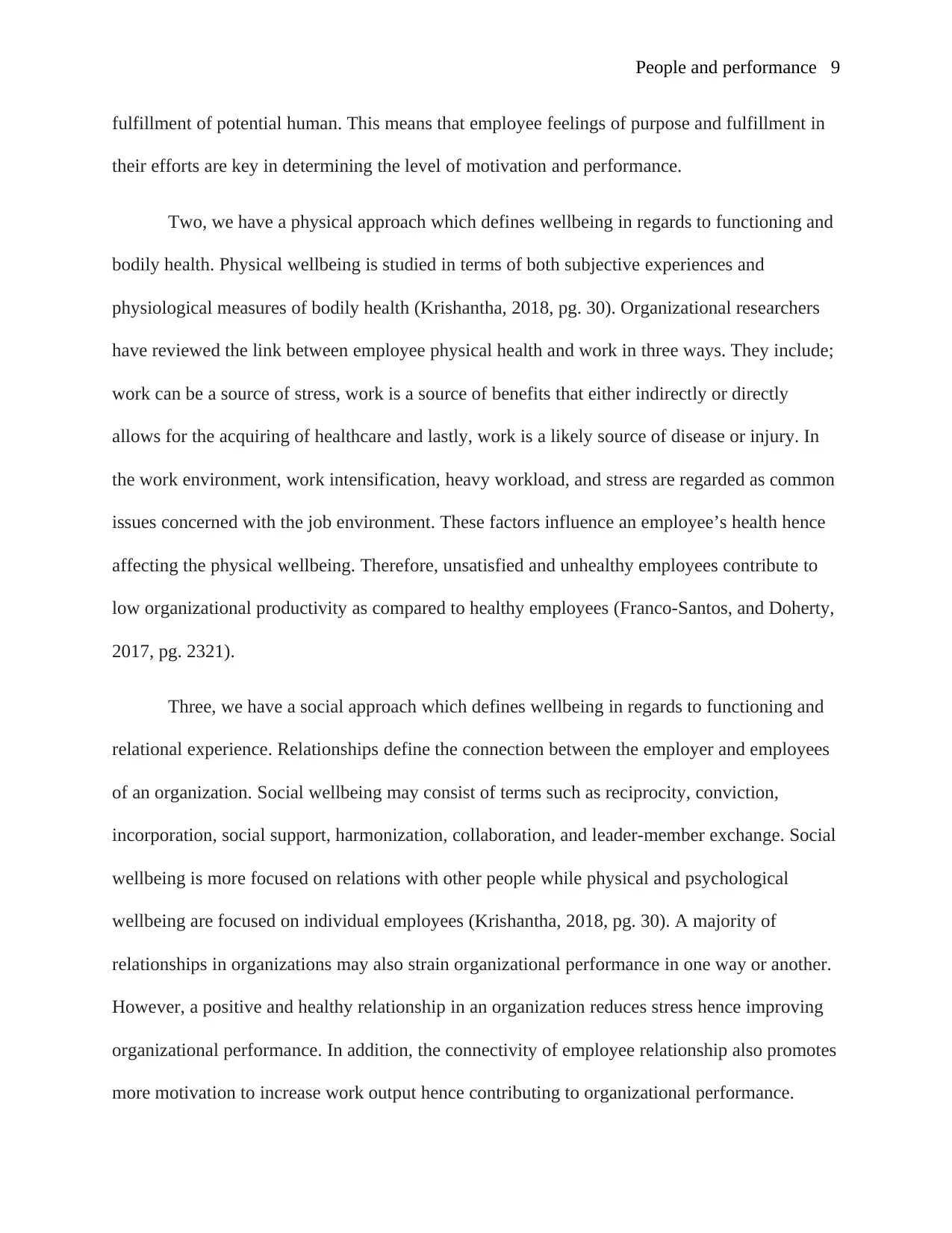
People and performance 9
fulfillment of potential human. This means that employee feelings of purpose and fulfillment in
their efforts are key in determining the level of motivation and performance.
Two, we have a physical approach which defines wellbeing in regards to functioning and
bodily health. Physical wellbeing is studied in terms of both subjective experiences and
physiological measures of bodily health (Krishantha, 2018, pg. 30). Organizational researchers
have reviewed the link between employee physical health and work in three ways. They include;
work can be a source of stress, work is a source of benefits that either indirectly or directly
allows for the acquiring of healthcare and lastly, work is a likely source of disease or injury. In
the work environment, work intensification, heavy workload, and stress are regarded as common
issues concerned with the job environment. These factors influence an employee’s health hence
affecting the physical wellbeing. Therefore, unsatisfied and unhealthy employees contribute to
low organizational productivity as compared to healthy employees (Franco-Santos, and Doherty,
2017, pg. 2321).
Three, we have a social approach which defines wellbeing in regards to functioning and
relational experience. Relationships define the connection between the employer and employees
of an organization. Social wellbeing may consist of terms such as reciprocity, conviction,
incorporation, social support, harmonization, collaboration, and leader-member exchange. Social
wellbeing is more focused on relations with other people while physical and psychological
wellbeing are focused on individual employees (Krishantha, 2018, pg. 30). A majority of
relationships in organizations may also strain organizational performance in one way or another.
However, a positive and healthy relationship in an organization reduces stress hence improving
organizational performance. In addition, the connectivity of employee relationship also promotes
more motivation to increase work output hence contributing to organizational performance.
fulfillment of potential human. This means that employee feelings of purpose and fulfillment in
their efforts are key in determining the level of motivation and performance.
Two, we have a physical approach which defines wellbeing in regards to functioning and
bodily health. Physical wellbeing is studied in terms of both subjective experiences and
physiological measures of bodily health (Krishantha, 2018, pg. 30). Organizational researchers
have reviewed the link between employee physical health and work in three ways. They include;
work can be a source of stress, work is a source of benefits that either indirectly or directly
allows for the acquiring of healthcare and lastly, work is a likely source of disease or injury. In
the work environment, work intensification, heavy workload, and stress are regarded as common
issues concerned with the job environment. These factors influence an employee’s health hence
affecting the physical wellbeing. Therefore, unsatisfied and unhealthy employees contribute to
low organizational productivity as compared to healthy employees (Franco-Santos, and Doherty,
2017, pg. 2321).
Three, we have a social approach which defines wellbeing in regards to functioning and
relational experience. Relationships define the connection between the employer and employees
of an organization. Social wellbeing may consist of terms such as reciprocity, conviction,
incorporation, social support, harmonization, collaboration, and leader-member exchange. Social
wellbeing is more focused on relations with other people while physical and psychological
wellbeing are focused on individual employees (Krishantha, 2018, pg. 30). A majority of
relationships in organizations may also strain organizational performance in one way or another.
However, a positive and healthy relationship in an organization reduces stress hence improving
organizational performance. In addition, the connectivity of employee relationship also promotes
more motivation to increase work output hence contributing to organizational performance.
⊘ This is a preview!⊘
Do you want full access?
Subscribe today to unlock all pages.

Trusted by 1+ million students worldwide
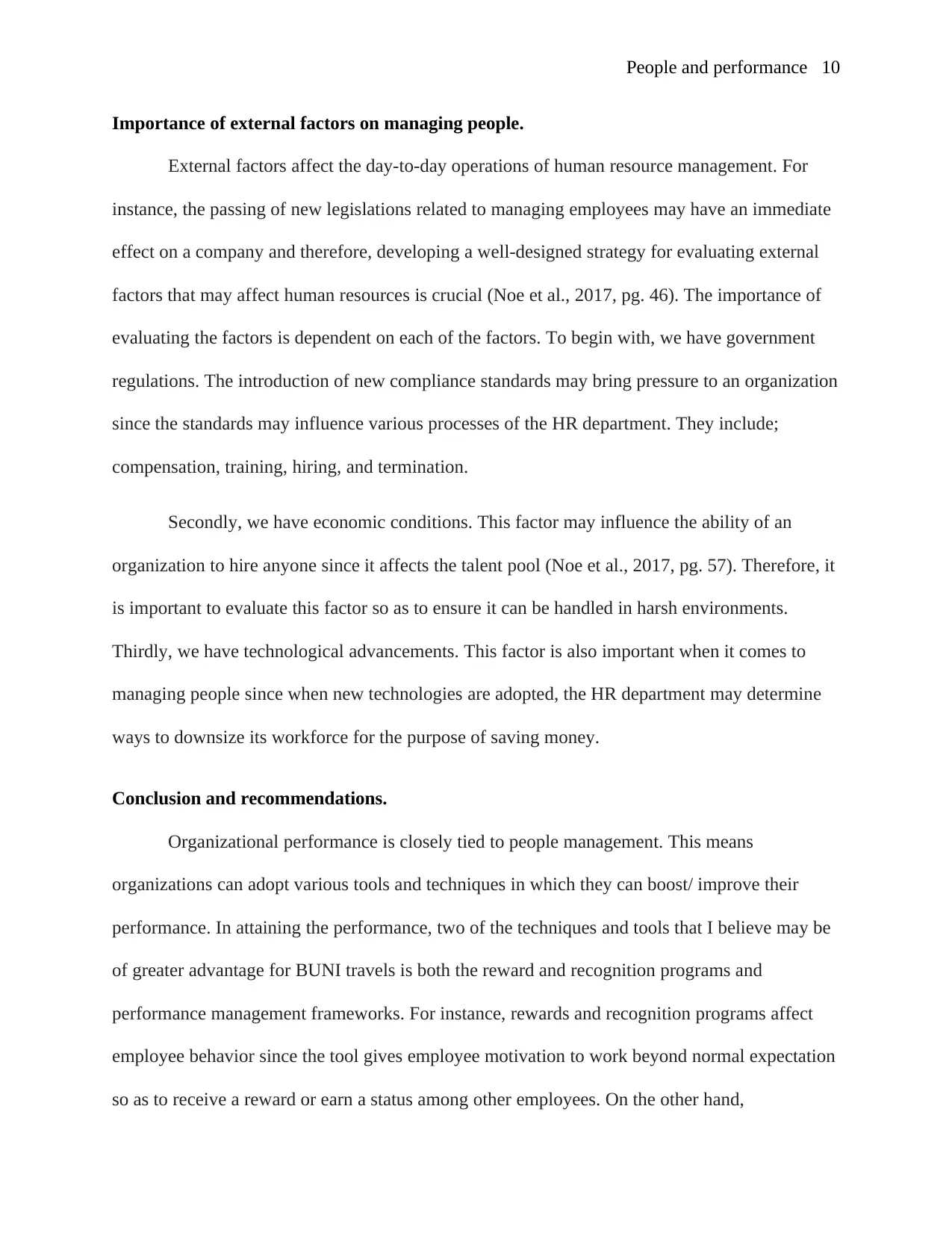
People and performance 10
Importance of external factors on managing people.
External factors affect the day-to-day operations of human resource management. For
instance, the passing of new legislations related to managing employees may have an immediate
effect on a company and therefore, developing a well-designed strategy for evaluating external
factors that may affect human resources is crucial (Noe et al., 2017, pg. 46). The importance of
evaluating the factors is dependent on each of the factors. To begin with, we have government
regulations. The introduction of new compliance standards may bring pressure to an organization
since the standards may influence various processes of the HR department. They include;
compensation, training, hiring, and termination.
Secondly, we have economic conditions. This factor may influence the ability of an
organization to hire anyone since it affects the talent pool (Noe et al., 2017, pg. 57). Therefore, it
is important to evaluate this factor so as to ensure it can be handled in harsh environments.
Thirdly, we have technological advancements. This factor is also important when it comes to
managing people since when new technologies are adopted, the HR department may determine
ways to downsize its workforce for the purpose of saving money.
Conclusion and recommendations.
Organizational performance is closely tied to people management. This means
organizations can adopt various tools and techniques in which they can boost/ improve their
performance. In attaining the performance, two of the techniques and tools that I believe may be
of greater advantage for BUNI travels is both the reward and recognition programs and
performance management frameworks. For instance, rewards and recognition programs affect
employee behavior since the tool gives employee motivation to work beyond normal expectation
so as to receive a reward or earn a status among other employees. On the other hand,
Importance of external factors on managing people.
External factors affect the day-to-day operations of human resource management. For
instance, the passing of new legislations related to managing employees may have an immediate
effect on a company and therefore, developing a well-designed strategy for evaluating external
factors that may affect human resources is crucial (Noe et al., 2017, pg. 46). The importance of
evaluating the factors is dependent on each of the factors. To begin with, we have government
regulations. The introduction of new compliance standards may bring pressure to an organization
since the standards may influence various processes of the HR department. They include;
compensation, training, hiring, and termination.
Secondly, we have economic conditions. This factor may influence the ability of an
organization to hire anyone since it affects the talent pool (Noe et al., 2017, pg. 57). Therefore, it
is important to evaluate this factor so as to ensure it can be handled in harsh environments.
Thirdly, we have technological advancements. This factor is also important when it comes to
managing people since when new technologies are adopted, the HR department may determine
ways to downsize its workforce for the purpose of saving money.
Conclusion and recommendations.
Organizational performance is closely tied to people management. This means
organizations can adopt various tools and techniques in which they can boost/ improve their
performance. In attaining the performance, two of the techniques and tools that I believe may be
of greater advantage for BUNI travels is both the reward and recognition programs and
performance management frameworks. For instance, rewards and recognition programs affect
employee behavior since the tool gives employee motivation to work beyond normal expectation
so as to receive a reward or earn a status among other employees. On the other hand,
Paraphrase This Document
Need a fresh take? Get an instant paraphrase of this document with our AI Paraphraser
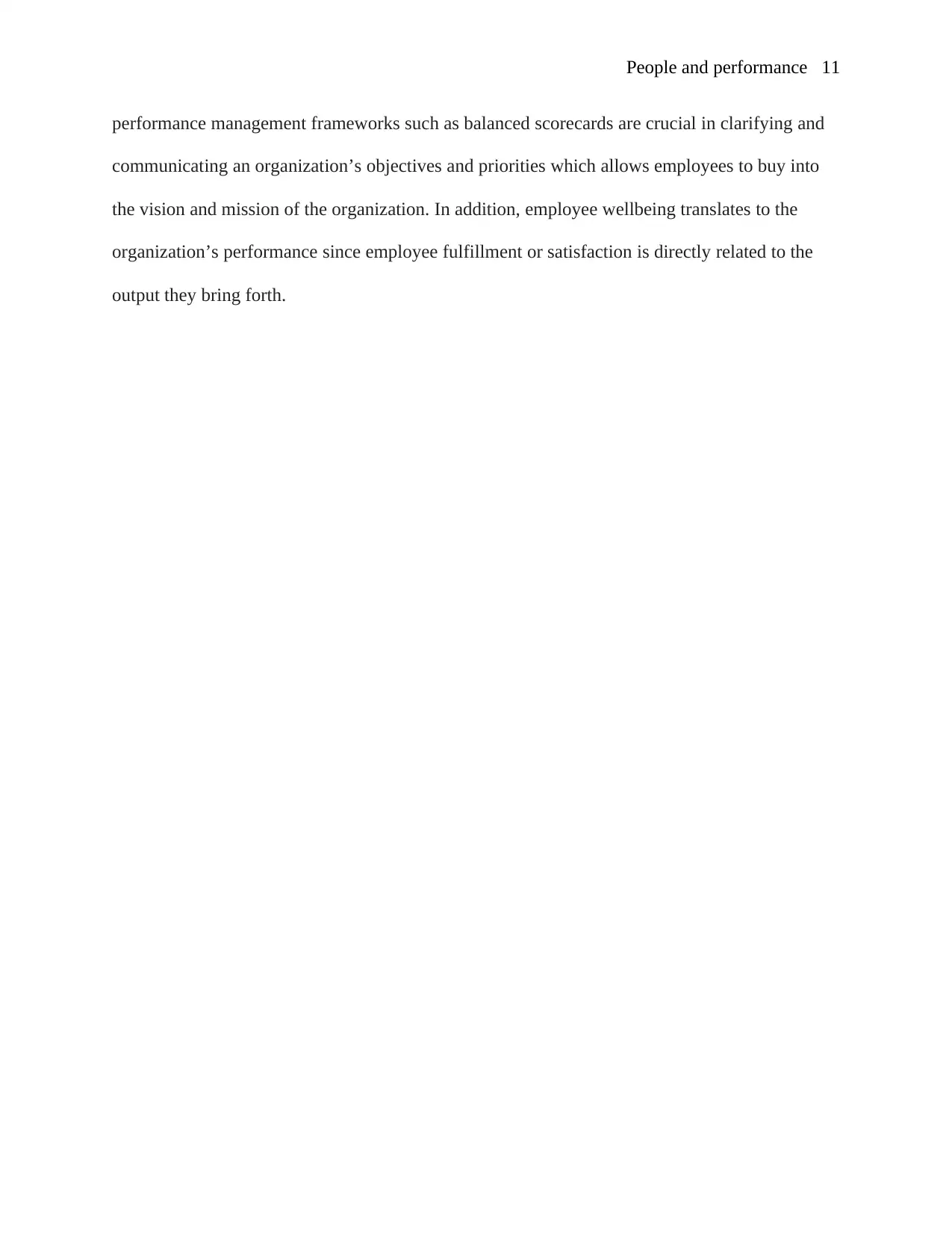
People and performance 11
performance management frameworks such as balanced scorecards are crucial in clarifying and
communicating an organization’s objectives and priorities which allows employees to buy into
the vision and mission of the organization. In addition, employee wellbeing translates to the
organization’s performance since employee fulfillment or satisfaction is directly related to the
output they bring forth.
performance management frameworks such as balanced scorecards are crucial in clarifying and
communicating an organization’s objectives and priorities which allows employees to buy into
the vision and mission of the organization. In addition, employee wellbeing translates to the
organization’s performance since employee fulfillment or satisfaction is directly related to the
output they bring forth.
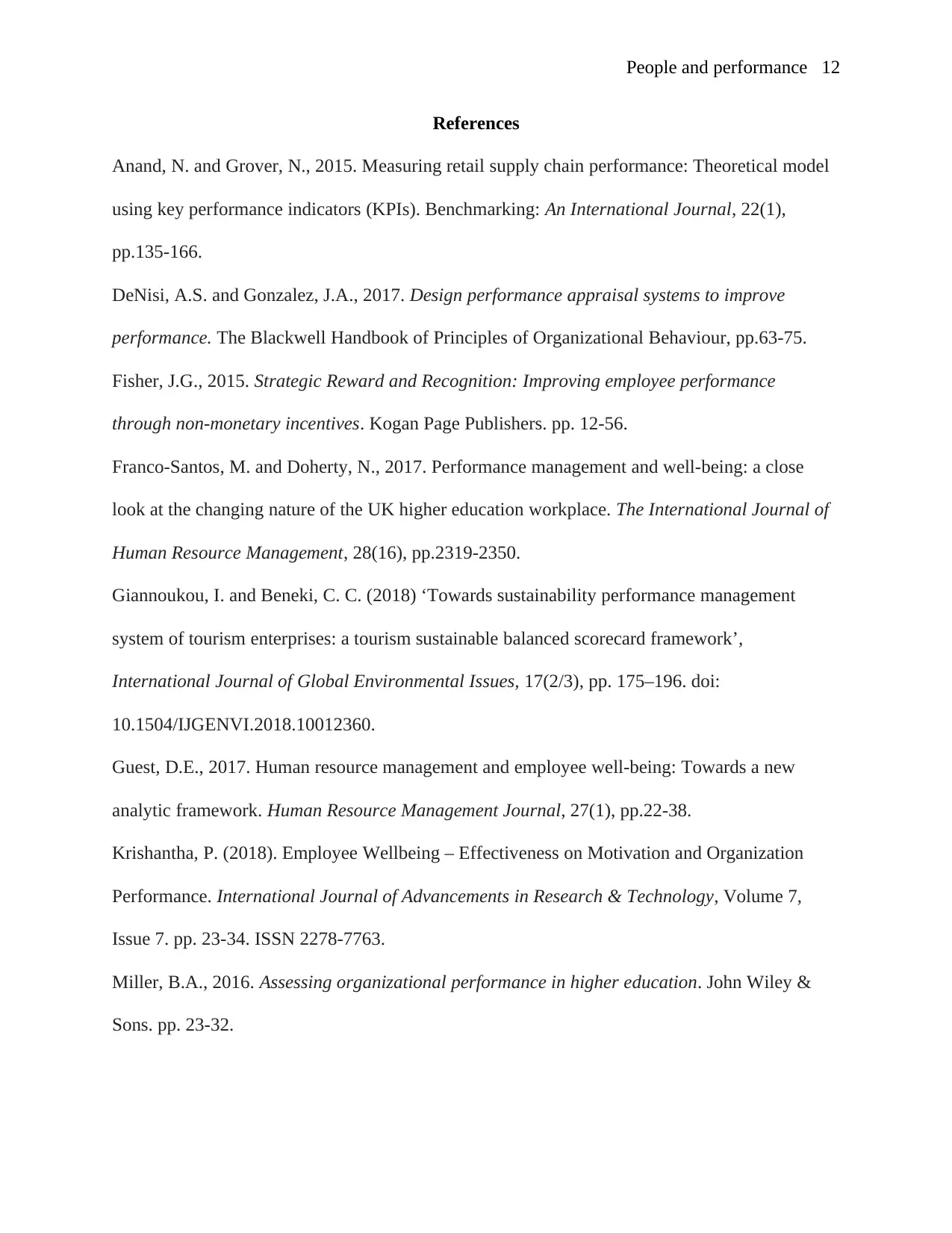
People and performance 12
References
Anand, N. and Grover, N., 2015. Measuring retail supply chain performance: Theoretical model
using key performance indicators (KPIs). Benchmarking: An International Journal, 22(1),
pp.135-166.
DeNisi, A.S. and Gonzalez, J.A., 2017. Design performance appraisal systems to improve
performance. The Blackwell Handbook of Principles of Organizational Behaviour, pp.63-75.
Fisher, J.G., 2015. Strategic Reward and Recognition: Improving employee performance
through non-monetary incentives. Kogan Page Publishers. pp. 12-56.
Franco-Santos, M. and Doherty, N., 2017. Performance management and well-being: a close
look at the changing nature of the UK higher education workplace. The International Journal of
Human Resource Management, 28(16), pp.2319-2350.
Giannoukou, I. and Beneki, C. C. (2018) ‘Towards sustainability performance management
system of tourism enterprises: a tourism sustainable balanced scorecard framework’,
International Journal of Global Environmental Issues, 17(2/3), pp. 175–196. doi:
10.1504/IJGENVI.2018.10012360.
Guest, D.E., 2017. Human resource management and employee well‐being: Towards a new
analytic framework. Human Resource Management Journal, 27(1), pp.22-38.
Krishantha, P. (2018). Employee Wellbeing – Effectiveness on Motivation and Organization
Performance. International Journal of Advancements in Research & Technology, Volume 7,
Issue 7. pp. 23-34. ISSN 2278-7763.
Miller, B.A., 2016. Assessing organizational performance in higher education. John Wiley &
Sons. pp. 23-32.
References
Anand, N. and Grover, N., 2015. Measuring retail supply chain performance: Theoretical model
using key performance indicators (KPIs). Benchmarking: An International Journal, 22(1),
pp.135-166.
DeNisi, A.S. and Gonzalez, J.A., 2017. Design performance appraisal systems to improve
performance. The Blackwell Handbook of Principles of Organizational Behaviour, pp.63-75.
Fisher, J.G., 2015. Strategic Reward and Recognition: Improving employee performance
through non-monetary incentives. Kogan Page Publishers. pp. 12-56.
Franco-Santos, M. and Doherty, N., 2017. Performance management and well-being: a close
look at the changing nature of the UK higher education workplace. The International Journal of
Human Resource Management, 28(16), pp.2319-2350.
Giannoukou, I. and Beneki, C. C. (2018) ‘Towards sustainability performance management
system of tourism enterprises: a tourism sustainable balanced scorecard framework’,
International Journal of Global Environmental Issues, 17(2/3), pp. 175–196. doi:
10.1504/IJGENVI.2018.10012360.
Guest, D.E., 2017. Human resource management and employee well‐being: Towards a new
analytic framework. Human Resource Management Journal, 27(1), pp.22-38.
Krishantha, P. (2018). Employee Wellbeing – Effectiveness on Motivation and Organization
Performance. International Journal of Advancements in Research & Technology, Volume 7,
Issue 7. pp. 23-34. ISSN 2278-7763.
Miller, B.A., 2016. Assessing organizational performance in higher education. John Wiley &
Sons. pp. 23-32.
⊘ This is a preview!⊘
Do you want full access?
Subscribe today to unlock all pages.

Trusted by 1+ million students worldwide
1 out of 15
Related Documents
Your All-in-One AI-Powered Toolkit for Academic Success.
+13062052269
info@desklib.com
Available 24*7 on WhatsApp / Email
![[object Object]](/_next/static/media/star-bottom.7253800d.svg)
Unlock your academic potential
Copyright © 2020–2025 A2Z Services. All Rights Reserved. Developed and managed by ZUCOL.



